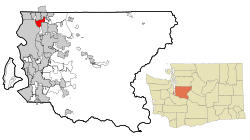Juanita, Kirkland, Washington facts for kids
Quick facts for kids
Juanita, Washington
|
|
|---|---|

Location of Juanita within King County, Washington, and King County within Washington.
|
|
| Country | United States |
| State | Washington |
| County | King |
| Elevation | 14–500 ft (4–152 m) |
| Time zone | UTC-8 (Pacific) |
| • Summer (DST) | UTC-7 (Pacific) |
| ZIP codes |
98033, 98034, 98083
|
| Area code(s) | 425 |
Juanita is a neighborhood in Kirkland, Washington. It is located along the northeast edge of Lake Washington. This area is one of the most historic parts of the Eastside region. Juanita used to be an unincorporated area controlled by King County. However, it gradually became part of Kirkland in 1967, 1988, and 2011.
Contents
History of Juanita
Early Native American Life
Juanita Bay was first home to members of the Duwamish tribe. They had a winter village with three longhouses. This village was at the mouth of Juanita Creek in what is now Juanita Bay Park. The village was called Tahb-tahb-iuh. This name might mean 'Loamy Place' in the Lushootseed language, referring to the soil.
The bay was a popular spot to gather wapatoes. These are aquatic plants with roots that can be eaten. Many Native residents died from smallpox in the mid-1800s. However, some continued to visit the area by canoe until at least 1917.
European Settlers Arrive
Kirkland's first European settlers made their homes in Juanita. One of them was Mary Jane Russell Terry. People believe she named the settlement "Juanita." This name came from the 1853 Spanish love song Nita Juanita by Caroline Norton. The earliest written mention of Juanita is from a settler's journal in 1873. It was misspelled as "Waneta" at that time.
Martin W. Hubbard and his family settled in Juanita in 1870. During the 1880s, the village and its post office were officially called "Hubbard." Martin Hubbard was the postmaster. He also made Juanita Bay a small port for steamers and ferries. He built a dock called Hubbard's Landing.
In 1876, Dorr Forbes, a veteran of the Civil War, settled in Juanita. Forbes moved his house from Madison Park across the lake by barge. This house had to be rebuilt after a fire in 1905. Around 1890, Forbes built a wooden bridge. This bridge connected the village to Kirkland's new Market Street. In 1902, Harry Langdon opened a feed store and service station. This was at what is now 98th Ave NE and NE 116th Ave. This area is still Juanita's main business district.
Growth and Annexation
Juanita became a popular resort area in the 1920s for people from Seattle. The Forbes family's second generation opened the Juanita Beach resort, which is now Juanita Beach Park. In 1917, Lake Washington Ship Canal construction lowered Lake Washington. This made Juanita Bay much smaller and better for recreation.
The town also grew in the 1920s when Lake Washington Boulevard was built through Juanita. This road was also known as highway 2-A. Businesses for cars were among the first to open along this road in Juanita. In 1950, a new, larger Juanita school was built. By the end of the 1950s, King County had bought most of the waterfront for public parks.
In the 1960s, farms and large homes in Juanita became subdivisions and shopping centers. The village started thinking about becoming its own city. At the same time, neighboring Kirkland wanted to add Juanita to its city limits. Most of Juanita became part of Kirkland in July 1967.
In 1971, a new, much larger Juanita High School opened. It had an open, experimental design. In 1988, a part of King County called lower Juanita became part of Kirkland. This happened along with the North and South Rose Hill neighborhoods.
In November 2009, people in North Juanita, Finn Hill, and Kingsgate voted to join Kirkland. These areas were not yet part of a city. King County encouraged this annexation. Also, the state's Growth Management Act offered money to help with the process.
Recreation and Parks
Juanita and its nearby areas have many parks for fun and outdoor activities. These parks include:
- Juanita Bay Park
- Juanita Beach Park
- Heronfield Wetlands (located in Kirkland city limits)
- Edith Moulton Park and Windsor Vista (within the Juanita neighborhood)
- Juanita Woodlands
- O.O. Denny Park
- Big Finn Hill Park
- Saint Edward State Park (in the Finn Hill Neighborhood, within both Kirkland and Kenmore city limits)
Transportation in Juanita
The main roads in Juanita are 100th Avenue NE, Juanita Drive, and NE 132nd Street. Several Metro bus lines serve Juanita, making it easy to get around.
Images for kids
See also
 In Spanish: Juanita (Washington) para niños
In Spanish: Juanita (Washington) para niños


